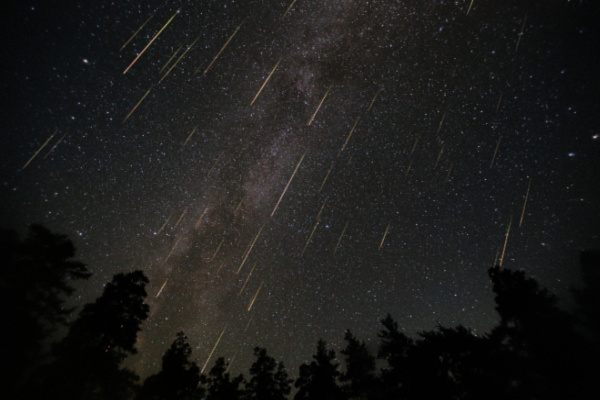At the start of every year, stargazers flip through their calendars and mark down the dates of big astronomy events ranging from eclipses to planetary alignments. The annual Perseids meteor shower is wildly popular and usually one of these can’t-miss events. This year the shower will peak between August 11-12, according to the American Meteor Society (AMS).
When conditions are perfect, the Perseids can boast up to 100 meteors per hour, one of the highest hourly rates of any annual meteor shower. Unfortunately, the peak of this year’s event will coincide with the final supermoon of the year, so the two big astronomy events will be fighting for nighttime dominance. This is why astronomers are cautioning that, depending on where you live, you may not get the usual “stellar” view due to the supermoon’s super glow. Still, some shooting stars should be able to make an impactful shining streak through the night skies.
The Perseids are caused by Earth passing through debris — bits of ice and rock — left behind by Comet Swift-Tuttle which last passed close to Earth in 1992. The Perseids peak when Earth passes through the densest and dustiest area on August 11-12. Years without moonlight see higher rates of meteors per hour, and in outburst years (such as in 2016) the rate can be between 150-200 meteors an hour. On a more normal year you can expect to see up to 100 meteors per hour at the shower’s peak, according to NASA.
According to Space.com, a typical Perseid meteoroid (which is what they’re called while in space) moves at 133,200 mph (214,365 kph) when it hits Earth’s atmosphere (and then they are called meteors). Most of the Perseids are tiny, about the size of a sand grain. Almost none of the fragments hit the ground, but if one does, it’s called a meteorite. Peak temperatures for Perseids are more than 3,000 degrees Fahrenheit (1,650 Celsius) as each fragment travels through the atmosphere and both compresses and heats the air in front of it. Most of the fragments are visible when they are about 60 miles (97 kilometers) from the ground.
You can see the Perseid meteor shower best in the Northern Hemisphere and down to the mid-southern latitudes, and all you need to catch the show is darkness, somewhere comfortable to sit and a bit of patience. When you sit back to watch a meteor shower, you’re actually seeing the pieces of comet debris heat up as they enter the atmosphere and burn up in a bright burst of light, streaking a vivid path across the sky as they travel at 37 miles (59 kilometers) per second, according to NASA.
To find the Perseid meteor shower, it’s a good idea to look for the point in the sky where they appear to originate from, this is known as the radiant. According to NASA, the Perseids’ radiant is in the Perseus Constellation. Though Perseus isn’t the easiest to find, it conveniently follows the brighter and more distinctive constellation Cassiopeia across the night sky. The meteor shower gets its name from the constellation it radiates from, the constellation is not the source of the meteors.
To best see the Perseids, go to the darkest possible location and lean back and relax. You don’t need any telescopes or binoculars as the secret is to take in as much sky as possible and allow about 30 minutes for your eyes to adjust to the dark.
—
Photo Credit: Makarov Konstantin / Shutterstock.com
